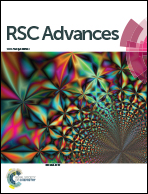Photocatalytic degradation of 4-chlorophenol over Ag/MFe2O4 (M = Co, Zn, Cu, and Ni) prepared by a modified chemical co-precipitation method: a comparative study
Abstract
In this study, MFe2O4 (M = Zn, Cu, Co and Ni) nanoparticles were prepared by a modified chemical co-precipitation method followed by annealing. Then, Ag/MFe2O4 nanoparticles were synthesised via a wetness impregnation method. The structural properties of the samples were systematically investigated by XRD, SEM, TEM, EDX, DRS, BET, SPV and FT-IR techniques. The photocatalytic performances of the prepared MFe2O4 and Ag/MFe2O4 samples were comparatively studied by the photodegradation of 4-chlorophenol under xenon lamp illumination in a FTIR reaction cell. The photodegradation rate of 4-chlorophenol was 90% for the Ag/CoFe2O4 sample. The cheap cost and easy synthesis of the photocatalysts indicate the potential for a better thermal disposal of chlorophenol pollutants at lower temperatures.


 Please wait while we load your content...
Please wait while we load your content...